The Flinders National Grammar School opened in January 1858, named after Captain Matthew Flinders.
The rail lines connecting Melbourne and Geelong began late in 1854, part of one of the first private railway companies in Victoria.
Architect Joseph Reed won the design completion for the Geelong Town Hall in 1855.
 |
| Market Square, Geelong 1856. Looking across Market Square towards clock tower, cattle and horse drawn covered wagons in square around clock tower, L-R in background: Frank Griffiths Wine and Spirits Merchants, Charles Gundry Glass & China, Dawson's Prince of Wales Family Hotel; street turning off on left, McLean Chemist on corner. SLVIC |
 |
| Laying the foundation stone for a clock tower in the Market Square. The Prince of Wales Hotel is in the background. Geelong, Victoria, 1856, Museums Victoria |
In 1857, C.J Dennys conducted the first wool auction in Geelong.
Construction work on the Geelong to Ballarat railway began in 1858.
The Free Presbyterian Church was built in 1858.
 |
| Elevated view of store from opposite side of street: Brick building signed: D.W. Petrie / P. McDonald / wholesale wine, spirit & provision merchant. Three men standing in porch, horse and cart at curb; a shop on right with sign: Mrs Simon straw bonnets cleaning and altered..., wooden building on left with posters: selling out, c1858, SLVIC |
RabbitsGrazier Thomas Austin released 12 pairs of wild rabbits on his property at Winchelsea, just outside Geelong, in 1859. Even though rabbits are thought to have
been introduced Australia by the First Fleet, Austin is often blamed for the devastating consequences of rabbits on the environment.
The Geelong Football Club was formed, 8 July, 1859, at the Victoria Hotel.
The Geelong Club, a private social club was originally established in 1859, as the Western Club.
1860s
Sacred Heart College, boarding and day school, opened in 1860. In 1861 an adjoining orphanage was opened.
The Geelong Synagogue was built in 1861. The building is no longer used as a synagogue.
 |
| Cobb and Go's, coach is front of Black Bull Hotel, Geelong. (This coach conveyed the English Eleven from Melbourne to Geelong in 1862).Weekly Times (Melbourne, Vic. : 1869 - 1954) |
By the late 1860s, Geelong experienced a period of stagnation and population decline. It was noted that:
"Had the bar across the harbour been eliminated before the [gold]rushes
began and had the railways to Melbourne and Ballarat been built more
quickly, it is conceivable that Geelong might have continued to rival
Melbourne as the commercial, if not the administrative, capital of the
State." [IW, p. 31]
The Geelong Racing Club was formed in 1866. However, the first race meet in Geelong was on 1 May 1841 at Corio.
1870s
 |
| View of ships in the harbour in Geelong, VIC, in the 1870's, with a small building on the pier in the foreground. SLVIC |
 |
| Elevated view looking across train tracks to a church, with the town behind, about 1870s, Geelong, VIC. SLVIC |
 |
| Shows Little Malop Street, looking west from Yarra Street. Market Square is to right of image. c1873, Geelong VIC |
 |
| Women workers examining sheets of paper, Fyansford Paper Mills near Geelong, c1875, SLVIC |
1880s
The first successful telephone call in Victoria was made in Geelong in 1877. After this, Geelong Telephone Exchange was established in the old Post Office in September 1888.
The Victoria’s Postmaster-General reported that by 1880, the post office had
delivered twenty-two million letters, including two million letters to and from Britain.
 |
View of the harbour and town of Geelong, Victoria. 1880
|
.jpg) |
| Ship at Geelong. Myrtle Holme (ship) Myrtle Holme, Loch Ness, Loch Garry and Thyatira, at anchor, circa about 1886 |
1890s
The cement works at Fyansford, Geelong, opened in 1890. Limestone deposits were located at nearby Batesford.
 |
| Richard Roche, blacksmith, Geelong, VIC, State Library of New South Wales |
Geelong was central to Victoria's transportation and export business of wool and wheat leaving the port.
 |
| Geelong pier alongside the Loch Katrine, the Hinemoa, and Lindfield, Geelong, VIC, 1894 |
 |
| The Geelong football team, VIC, Melbourne Punch (Vic. : 1855 - 1900), Thursday 8 June 1899 |
 |
| Female inmates at Geelong Prison, VIC, C.1890s |
Aboriginal DisplacementThe rapid pace of European colonisation and land transformation led to desperate times for many Aboriginal people. Although many worked in various occupations, mostly on agricultural properties.
In June 1863, 2300 acres were gazetted as a reserve for Coranderrk Aboriginal Station, near Healesville to the east of Melbourne. Many Kulin Nation people settled here. The Scottish manager John Green and Aboriginal leaders, Simon Wonga and William Barak, ran the reserve successfully, as the Aboriginal people were educated and yet also, allowed to practice many of their customs and traditions.
At the Coranderrk Reserve, Aboriginal people also built homes, farmed the land and made and sold products, such as cloaks, baskets, boomerangs and other artefacts. In 1863 an emu skirt was sent by Aboriginal people living at Coranderrk as a gift to Queen Victoria upon her marriage. The reserve closed in 1923.
 |
| A group of interested children gather around at Coranderrk. Healesville, watching an Aboriginal man make a boomerang Argus (Melbourne, Vic. : 1848 - 1957), Saturday 21 November 1931 |
1900sA power station was located on the corner of Yarra and Brougham Streets in the city. Work began in 1900 and finished in the following year.
 |
| Geelong brewery, VIC, Leader (Melbourne, Vic. : 1862 - 1918, 1935), Tuesday 1 January 1901 |
Rippleside Pier (Balmoral Quay also known as Cunningham Pier) was the hub of Geelong's shipping industry. Built in 1905, the pier operated until 1970.
 |
| Geelong Agricultural Show, VIC, Punch (Melbourne, Vic. : 1900 - 1918; 1925), Thursday 14 November 1907 |
20 Horse-Power
"THE IMPERIAL OIL MOTOR. The story of how Mr. J. H. Dardel, of "Chamnont," Batesford, near Geelong,ploughed 120 acres of particularly stiff land without the aid of either horses or steam plant marks an important epoch in the agricultural development of Australia. As, the picture indicates, two four-furrow disc ploughs were used in the work, the motive power being supplied by a 20-horse oil
tractor." |
| Mr. J. H. Dardel, of "Chamnont," Batesford, near Geelong,ploughed 120 acres Leader (Melbourne, Vic. : 1862 - 1918, 1935), Saturday 4 December 1909 |
 |
| 60 years in Australia, Arrival of the ship Larpent at Corio, Weekly Times (Melbourne, Vic. : 1869 - 1954), Saturday 10 July 1909 |
 |
| Opening of the Gordon Institute of TAFE, 1910, Geelong, VIC, SLVIC |
1910: A City
Geelong officially became a city on 8 December 1910. Electric lights and electricity became available after the Geelong Power Station was built in 1902.
The Geelong Harbour Trust was formed in December 1905. the Geelong Waterworks and Sewerage Trust formed in 1908 to administer and supply water sewerage services for the Town of Geelong and District.
 |
| Punch (Melbourne, Vic. : 1900 - 1918; 1925), Thursday 27 February 1908 |
 |
| Mack's Hotel, Geelong, Victoria - 1910, Kaye |
 |
| Melbourne Electricity Supply Co, Baker Electric Lorry, Geelong, Victoria, Dec 1912. Public Domain |
 |
Opening of the Geelong tramway in 1912, Moorabool Street, Geelong, VIC |
TramsGeelong had an extensive tramway system from 1912 until 1956,
 |
| Ryrie Street, Geelong, VIC. early 1900s. Kaye |
 |
| Advertising for Ising's store in Geelong, Victoria - early 1900s, Kaye |
 |
| Geelong Harb our Trust Band, winners of double event in Ballarat, Victoria - 1910, Kaye |
WWIDuring World War I, Osborne House was used as a military hospital. Then between 1919 and 1924, the building was used as a base by the Royal Australian Navy Submarine Service for the J-class submarine.
 |
| Osborne House, Geelong, VIC, was built in 1858 for local squatter, Robert Muirhead. Sun (Sydney, NSW : 1910 - 1954), Sunday 2 March 1913 |
 |
| First World War, 1914-1918. Recruits in the 4th Machine Gun Company in training camp at the Geelong showground at rifle practice. Those standing behind are marking scores. Corporal Charles Carey McPhee is marked with X. (Original print held in AWM PR91/091). (Donor: G. Jarvis) AWM |
 |
| Mrs Collins of Moorak, Geelong, gave a garden party for returned military nurses at their convalescent home, Osborne House, Geelong, VIC, Matron Marguerite ( Madge) Hayes AANS [born at Ingelby Winchelsea 1882) was appointed Sister in Charge at Osborne House. She is seated centre row, 4th from left Australasian (Melbourne, Vic. : 1864 - 1946), Saturday 23 November 1918 |
The Archibald PrizeJules François Archibald, known as J. F. Archibald (1856 – 1919), was a co-owner and editor of
The Bulletin during its heyday.
Born at Kildare, Victoria (now known as Geelong West), Archibald changed his forenames in later life "when he became an enthusiast in everything French".
After his death, Archibald bequeathed money for the Archibald Fountain in Sydney's Hyde Park and the Archibald Prize for portraiture: now a famous and prestigious art prize in Australia.
1920s
Geelong
developed the reputation of being a "sleepy hollow", a term which has been parodied in an advertising campaign in recent years called: Geelong Reinvented.
However, the motor car manufacturing industry established in Geelong in the 1920s boosted Geelong's reputation as a bustling and motivated town.
The Prince of Wales
 |
| The Prince of Wales at Geelong, VIC, Weekly Times (Melbourne, Vic. : 1869 - 1954), Saturday 12 June 1920 |
 |
| This (A)aboriginal grinding-stone or hammer was discovered on Thursday by Mr. G. H. Morton, and identified by Mr. S. F. Mann. Messrs. Morton and Mann are directors of the Phosphate Company, on whose building site at Geelong the stone was found.Argus (Melbourne, Vic. : 1848 - 1957), Wednesday 19 December 1923 |
The Geelong and District Kitchener Memorial Hospital opened on 13 March 1924.
In 1926, George Lindsay and Alex McKenzie opened a drapery store in Geelong. The store primarily sold dress fabrics, manchester and furnishings. This was the beginning of the retail chain, Target.
The Geelong suburb of Highton was struck by tornado in 1926.
Ford
Ford Motor Company of Australia Limited which opened in 1925, shut down its Broadmeadows and Geelong car manufacturing plants in 2016, ending the 91-year Australian car industry.
 |
| Ford Model T parked outside the Geelong Library, VIC, at its launch in Australia in 1925 |
Target
In 1926, George Lindsay and Alex McKenzie opened a drapery store in Geelong. The store primarily sold dress fabrics, manchester and furnishings. This was the beginning of the retail chain, Target.
The Geelong suburb of Highton was struck by a tornado in 1926.
 |
| Geelong suburb of Highton is struck by tornado, Chronicle (Adelaide, SA : 1895 - 1954), Saturday 31 July 1926 |
1930s
 |
| Table Talk (Melbourne, Vic. : 1885 - 1939), Thursday 20 February 1930 |
3GL
Radio station 3GL on the AM band began in Geelong in 1930 but was broadcast over most of the Melbourne metropolitan area.
 |
| Advocate (Melbourne, Vic. : 1868 - 1954), Thursday 18 January 1934 |
 |
| Ships docked at Yarra Street Pier, Geelong, VIC, [Apr. 21, 1933], SLVIC |
 |
| Breakwater Tannery and Fellmongery and Henry O'Berne Wool Scourer, Breakwater, Geelong, c1937, SLVIC |
 |
| Moorabool street, Geelong, VIC, date rage 1920s-30s |
Legend of Geelong
Moi-Yo Miller (b. 1914) was the stage name of Mona Loretta Miller, who travelled the world as the Great Magician Dante's assistant.
Described as a "rare flower" who was able to fold up "like a piece of Chinese silk" and as "Australia’s most beautiful woman", Miller was also responsible for invigorating the costumes, music and choreography of Dante's acts. She became a headline act in her own right in 1935.
Moi-Yo Miller (died at the age of 104 in 2018. A legend of Geelong.
 |
| Moi-Yo Miller (b. 1914) was the stage name of Mona Loretta Miller |
Bombing
Detective Constable Fred Milne of the Geelong Police, found his home at 6 Manning St, Newtown, had been blown up by two bomb blasts on 13 July 1936. Milne had been involved in investigating criminals like Squizzy Taylor in Melbourne. He moved his family to Geelong, and this happened
 |
| Bombs at Geelong 1936, Argus (Melbourne, Vic. : 1848 - 1957), Tuesday 14 July 1936 |
 |
| Loading wheat at Geelong, Victoria - circa 1930s, Aussie Mobs |
 |
| Old Geelong Camp, Group of men in military uniform gathered near a tent, trees and picket fence in background, SLVIC, 1930s |
 |
| Swimming pool at Geelong, VIC, Age (Melbourne, Vic. : 1854 - 1954), Friday 3 February 1939 |
1940s and WWII
 |
| A.I.F. troops during meal times at military camp at Geelong, c1940, SLVIC |
 |
| Transport drivers standing in front of their vehicles awaiting instructions, Osbourne House, Geelong, VIC, Australasian (Melbourne, Vic. : 1864 - 1946), Saturday 8 March 1941 |
 |
| Geelong, VIC, Australasian (Melbourne, Vic. : 1864 - 1946), Saturday 8 March 1941 |
 |
| Mercury (Hobart, Tas. : 1860 - 1954), Tuesday 21 October 1941 |
 |
| Moorabool Street, Geelong, VIC, 1940s |
 |
| Geelong's new Textile College, VIC,Weekly Times (Melbourne, Vic. : 1869 - 1954), Wednesday 9 October 1946 |
 |
| Geelong's new Textile College, VIC,Weekly Times (Melbourne, Vic. : 1869 - 1954), Wednesday 9 October 1946 |
 |
| Geelong A power station in 1948, VIC |
 |
| Ryrie Street, Geelong, Victoria - 1940s, Aussie Mobs |
1950s
 |
| Swimming pool and gardens at Eastern Beach, Geelong, Victoria - circa 1950, Aussie Mobs |
 |
| Geelong Grammar School portraits, approximately 1950, NLAUST |
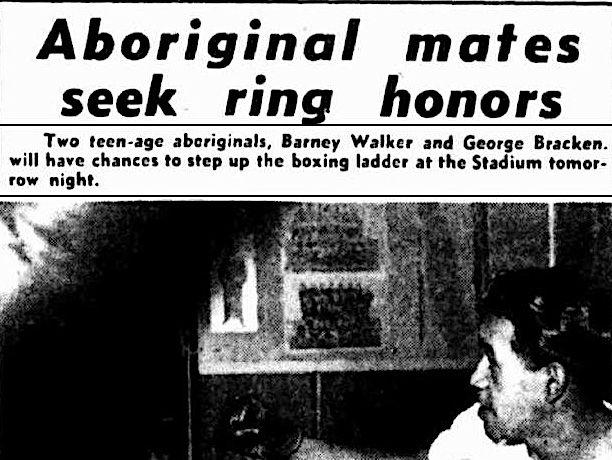 |
Aboriginal mates seek ring honors Two teen-age aboriginals, Barney Walker and George Bracken,
will have chances to step up the boxing ladder at the Stadium tomorrow night. Herald (Melbourne, Vic. : 1861 - 1954), Thursday 18 June 1953 (this is Barney Walker) |
 |
George BRACKEN, a former drover-is a familiar sight on horseback in the Geelong district
and popular with children.Herald (Melbourne, Vic. : 1861 - 1954), Thursday 18 June 1953 |
The Shell refinery opened in 1956.
In 1953 a government report recommended replacing the Geelong's trams with buses.
1960s
The smelter at Point Henry opened in 1963, operated by Alcoa World Alumina and Chemicals Australia. It closed in 2014.
 |
| Ford factory Geelong, VIC, c1968, Matt W |
1970s
The State Government Offices, known by locals as the "Upside-down" building, was built in the Brutalist style in 1978.
 |
| Shell oil Refinery, Geelong, VIC, c1976, Matt W |
 |
| Geelong, VIC, early 1980s, Matt W |
2000s
 |
| Tallship at the The Geelong Weekend 2006, Geelong, VIC, Brian Yap. This regatta is held in Geelong every Australia Day |
 |
| Eastern Beach, Geelong, Eastern Beach, Geelong, 2010, Boobook48 |
 |
| Pako Festa, Geelong, VIC, 2015, A festival that celebrates cultural diversity, the largest in Australia. Boobook48 |
Around Geelong
 |
| Osborne House is a historic building built in 1858, located in North Geelong, VIC. The Geelong Maritime Museum is housed in the renovated stables of Osborne House |
 |
| Cunningham Pier is probably the most iconic structure on our magnificent waterfront. Opening in the mid 1850’s, the pier was a vital part of our port with rail being used to load and unload cargo up until the late 1970’s. With the modernisation of Geelong’s ports, Cunningham Pier was no longer suitable and fell into disuse.Other than the odd visiting naval vessel Cunningham Pier sat dormant for many years. But in 1989, some local entrepreneurs saw the potential of the green cargo shed on the pier and started the first of what became an institution on Geelong’s social calendar, New Year on the Pier. This mammoth event turned the goods shed into a huge nightclub with thousands seeing in the New Year. New Year on the Pier remained on the pier each new year until the pier was sold off in the 1990’s, forcing a slight name change to the event when it became New Year by the Pier. Bernard Spragg. NZ |
 |
| Geelong Town Hall, VIC, circa 1855 |
 |
| The Geelong Bollards are painted wooden bollards representing over 100 historic Geelong characters, and are one of the main attractions for people visiting Geelong. Bernard Spragg. NZ |
 |
| A nice looking red brick home overlooking Geelong's Eastern Beach, VIC, Alpha |
 |
| Matthew Flinders Girls Secondary College, Geelong, VIC, Wongm |
 |
| The Gordon Institute, in Geelong, VIC, began as a technological college in 1869 |
 |
| The Colonial Mutual Life Assurance Building, Market Square, Geelong, VIC |
 |
| The former Telegraph Station in Geelong, VIC, was built in 1857-8 |
 |
| Victorian Austin Terraces and. Hall with three storey central clock tower clock tower constructed around 1886, Geelong, VIC |
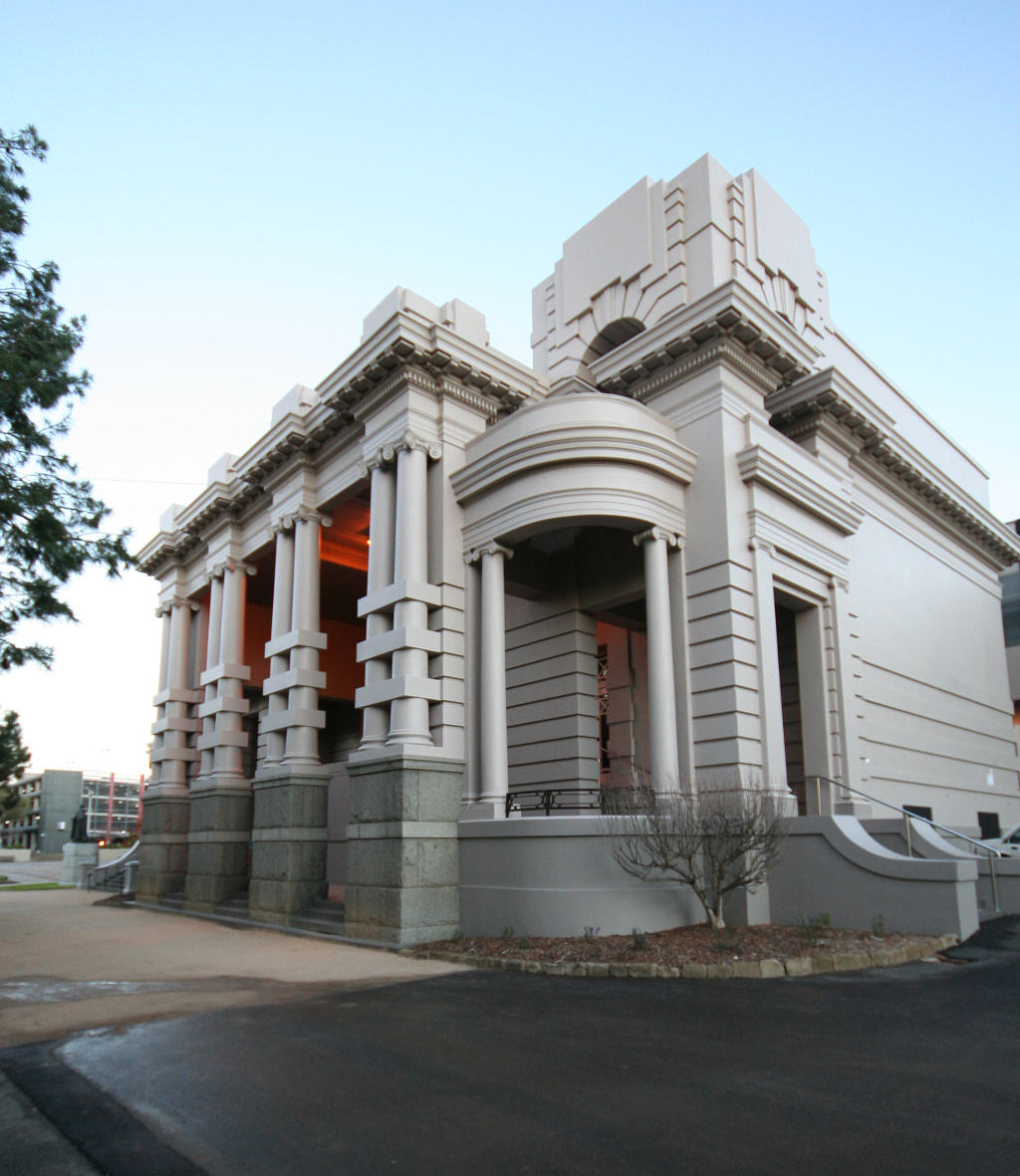 |
| Johnstone Park war memorial - Geelong Victoria Australia, circa 1926 |
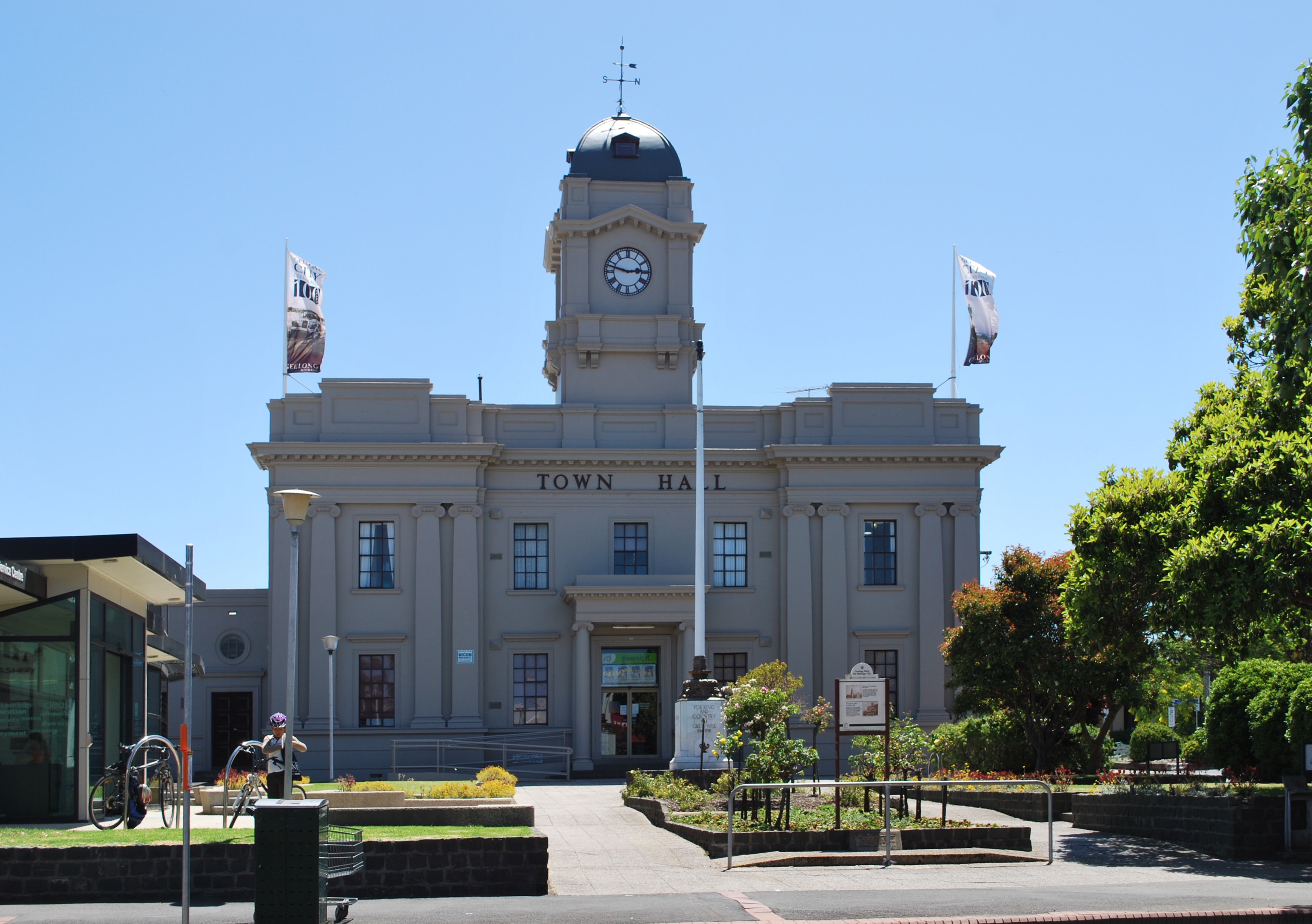 |
| The Geelong West City Hall, VIC, erected 1923-24 |
 |
| Geelong West Post Office, VIC, circa 1887-1987 |
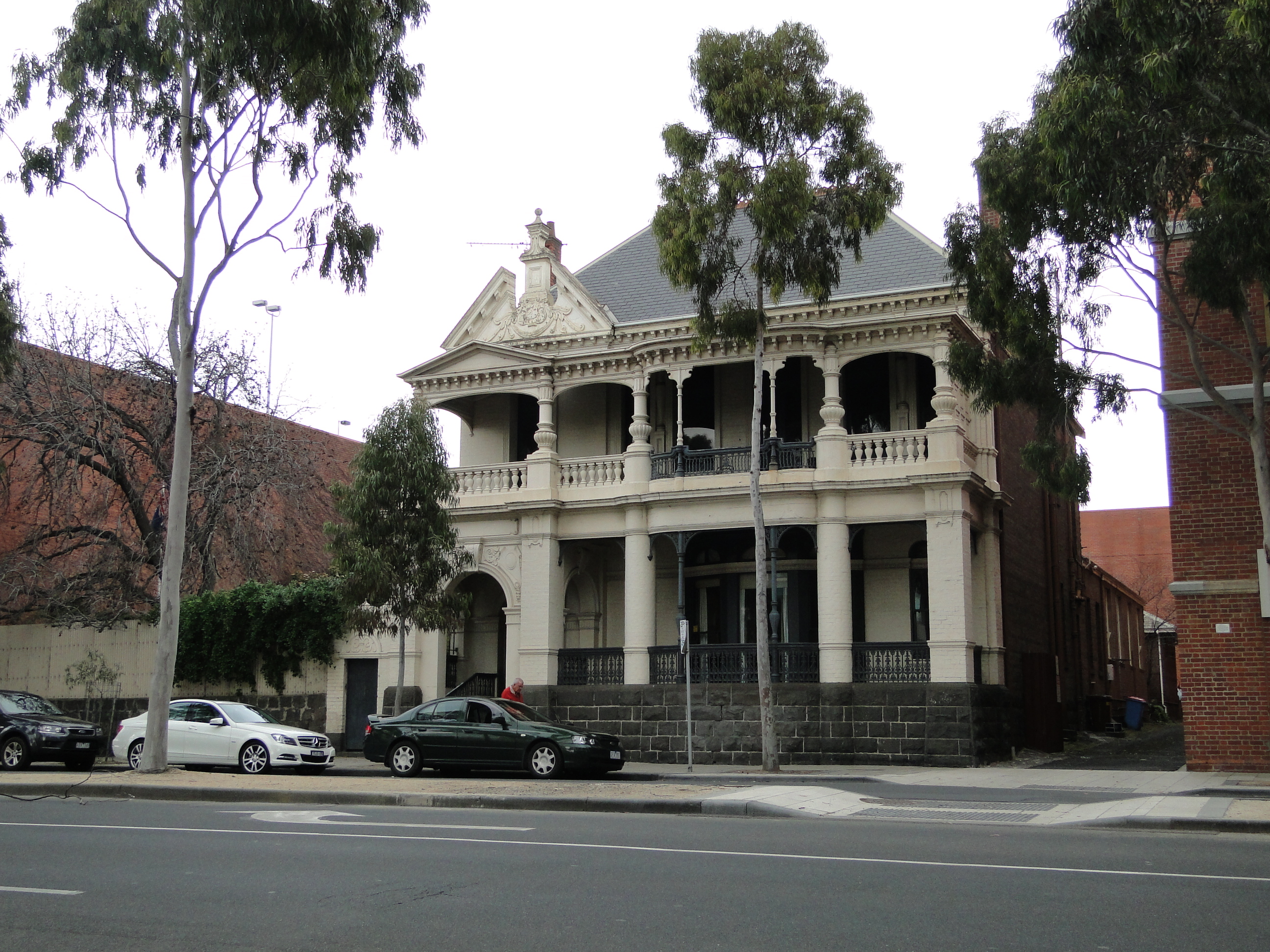 |
| The Geelong Club, VIC, at 74 Brougham Street, Geelong. club, formed in 1881, and the building completed in 1889. |
 |
| Main building of Matthew Flinders Girls Secondary College, circa 1856-7, Geelong, VIC |
 |
| HM Prison Geelong, VIC, built in stages from 1849 to 1864 |
 |
| Geelong Customs House, built circa 1858. denisbin |
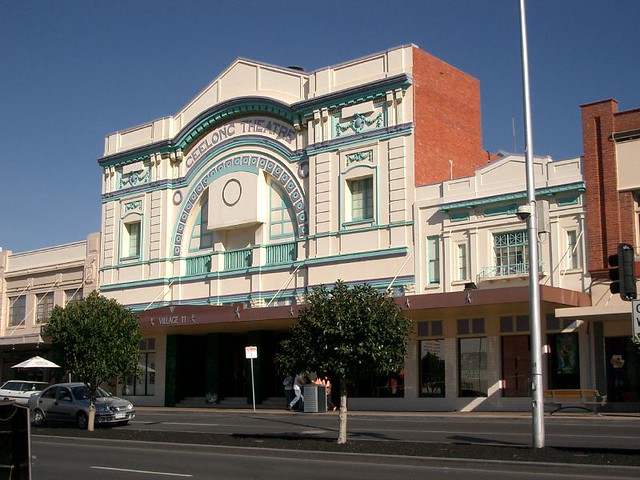 |
Art Deco style theatre, Geelong, VIC, Alpha
 |
| Corio Villa, Eastern Beach Road, crica 1856, Geelong, VIC |
|
 |
| Eudoxus, Fenwick Street, circa 1854-55, VIC |
 |
| The Terminus Hotel, Geelong, VIC, was built in 1853-54 |
 |
| St Mary's Hall, Geelong, VIC |
 |
| The wool exchange, Geelong, Corio St, VIC, was constructed in 1927 |
 |
| The Former George and Dragon Hotel, Moorabool Street, Geelong, VIC, circa 1855 |
 |
| The former Geelong Synagogue was built in 1861, VIC |
 |
| Belleville, Ryrie Street, Geelong, VIC, circa 1870-71 |
 |
| Fernshaw, 4 Western Beach, circa 1876, Geelong, VIC |
 |
| 310 Moorabool St. The old Haymarket Hotel, Geelong VIC, established in 1855, denisbin |
 |
| Art Deco and heritage listed T&G buildinG, built 1934, Geelong, VIC |
 |
| This shop erected 1854 in basalt as single storey. Later became a pharmacy shop making cough mixture. Chemist added upper floor in flamboyant style with minarets, cupolas etc in 1880s, Geelong, VIC, denisbin |
 |
| Former Presbyterian manse, Geelong, VIC, built 1888 |
 |
| 2 Myers Street corner of La Trobe Tce. The former but brightly painted stone Free Presbyterian Church. Built in 1858, Geelong VIC, denisbin |
Things To Do and Places To Go












.jpg)





































































































